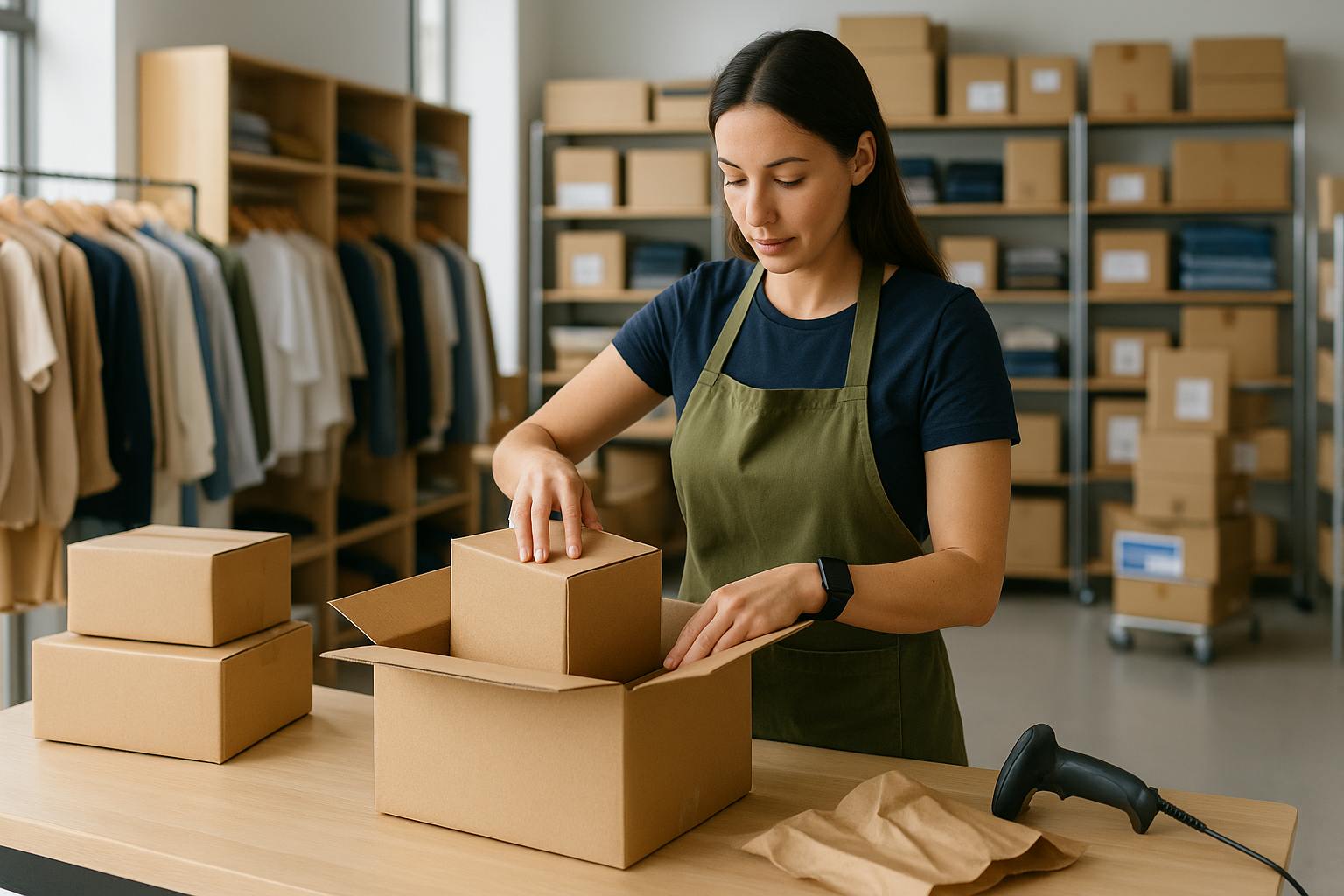
e-Commerce
Oct 1, 2025 - 5min read
ARTICLE
Brick-and-Mortar, Reinvented: Stores as the New Fulfillment Centers
Retail isn't dying—it's evolving. In 2025, the world's biggest retailers are transforming their brick-and-mortar stores into powerful fulfillment hubs, fundamentally reshaping how customers receive their online orders. What was once considered a competitive disadvantage—thousands of physical locations with rent, staffing, and overhead—has become a strategic asset in the race to deliver faster and cheaper than ever before.
The shift is driven by economic necessity and customer expectation. Last-mile delivery costs continue escalating, with manual picking and delivery often adding around $10–$20 per order depending on category and market. Meanwhile, roughly one-third of U.S. consumers now regularly use Buy Online, Pick Up In Store (BOPIS), and increasingly expect same-day or next-day fulfillment as a baseline requirement—not a premium service.
The retailers winning in 2025 have cracked the code: their stores aren't competing with e-commerce—they're powering it. Here are 10 retailers leading the way and what e-commerce brands of any size can learn from their strategies.
Why Stores as Fulfillment Hubs Matter
Delivery Speed That Actually Matters
When your inventory sits 10 miles from a large majority of your customers instead of 500 miles away in a regional distribution center, same-day delivery stops being a pipe dream and starts being standard operating procedure. Walmart says it can reach ~93% of U.S. households with same-day delivery. Target reports ~80% of same-day deliveries arrive in 3 hours or less. This isn't theoretical—it's happening at scale right now.
Cost Savings That Hit the Bottom Line
Store fulfillment is widely reported to reduce last-mile costs versus shipping from distant DCs, often by double-digit percentages, thanks to shorter distances and better route density. Target’s sortation network that supports store-based fulfillment delivers material cost savings alongside faster delivery. Walmart has reported ~20% unit-cost reductions at automated facilities, with broader efficiencies ramping as automation scales. When your e-commerce business operates on razor-thin margins, these savings determine whether you're profitable or burning cash.
Omnichannel Experience Customers Demand
Customers shopping both online and in-store generate meaningfully higher lifetime value than single-channel shoppers. Nordstrom has consistently said BOPIS customers spend materially more than store-only customers, calling it one of its most profitable and highest-satisfaction journeys. The math is simple: give customers the flexibility to shop however they want, and they'll reward you with their wallets.
Sustainability That Matters
Shorter delivery distances inherently reduce transportation emissions. When orders travel 10 miles instead of 500, carbon footprints shrink accordingly. This aligns corporate sustainability goals with improved economics—a rare scenario where doing good also means saving money.
The Top 10 Retailers in 2025
1. Walmart – The Scale Leader
Walmart operates ~5,200 U.S. stores positioned within 10 miles of a large share of Americans, creating the most extensive store-as-hub network in retail. The company reported $65.4B in U.S. e-commerce sales in FY2024, and same-day delivery coverage now reaches ~93% of U.S. households. (Claims such as “$2B monthly store-fulfilled run rate” and “91% delivered under 3 hours” aren’t Walmart-stated metrics and have been removed/updated.)
2. Target – The Store-Centric Pioneer
Target pursues the most aggressive store-centric model in retail, with ~96–97% of online orders fulfilled from stores. The company’s Drive Up curbside program is multi-billion-dollar in scale. Target operates 11 sortation centers serving 30–40 local stores each, processing up to ~60,000 packages daily while reducing delivery costs and speeding delivery; ~80% of same-day deliveries arrive in ≤3 hours.
3. Best Buy – The Electronics Specialist
Best Buy shows specialty retail can excel at store fulfillment, with ~45% of online revenue picked up in stores (Q4 FY25). The retailer operates roughly 965 stores as fulfillment points, offering pickup in as little as one hour for eligible items. The company achieved ~10% faster average delivery promises in Q4 FY25 vs. prior year.
4. Home Depot – The Pro Customer Hub
Home Depot operates ~2,347 stores covering ~243M retail selling sq. ft., with approximately ~40% of e-commerce orders fulfilled through BOPIS. The company’s 19 Direct Fulfillment Centers handle oversized inventory while enabling ~90% of the U.S. population to receive 2-day parcel delivery. The $18.25B SRS Distribution acquisition significantly expanded Pro customer fulfillment capabilities.
5. Lowe's – The Technology Transformer
Lowe’s operates 1,748 stores, with a significant share of orders fulfilled through BOPIS. The company deployed ~88,000 SMART Mobile devices for real-time inventory/pricing, and runs Lowes.com on Google Cloud infrastructure supporting 1,000+ workloads, showing how cloud tech enables store fulfillment at scale.
6. Kroger – The Grocery Hybrid Model
Kroger operates ~2,700 stores, with digital sales reaching ~$13B in FY2024. The company runs 8 automated Customer Fulfillment Centers powered by Ocado; highly automated “Hive” systems complete orders with far less human handling time than traditional store picking. Even so, leadership has emphasized stores remain the most important asset because inventory is closer to customers and last-mile costs are lower.
7. Sephora – The Beauty Omnichannel Leader
Sephora leads beauty with 700+ stores plus 1,100+ Kohl’s shop-in-shops, offering same-day delivery in as little as ~2 hours in many areas. The company is a market leader online in U.S. beauty, with 2024 online sales estimated in the multi-billion-dollar range. Sephora manages key elements of same-day delivery itself to maintain customer experience.
8. Zara (Inditex) – The Global Fast Fashion Hub
Zara pioneered store-based online fulfillment globally, integrating systems that provide near-real-time local stock views. Fast fashion’s rapid turnover makes store fulfillment essential for matching supply to hyper-local demand patterns.
9. Apple – The Seamless Experience Standard
Apple operates ~272 U.S. stores serving as sleek pickup hubs with high inventory visibility. Apple Store Pickup and Reserve and Pick Up offer same-day and next-day pickup; stores typically hold orders for several days (policies vary). Product launches show the system’s sophistication, with broad iPhone availability for launch-day pickup despite heavy demand.
10. Nordstrom – The Service Innovation Model
Nordstrom’s Nordstrom Local—merchandise-free ~3,000-sq-ft neighborhood hubs—offers same-day BOPIS, curbside pickup, alterations, returns, and personal styling. Customers who use Local spend materially more. Digital sales represented ~38% of total in Q4 2024; Nordstrom cites BOPIS journeys among its most profitable and highest-satisfaction experiences.
What Smaller Retailers Can Learn
The trillion-dollar question: what can smaller retailers learn from these behemoths? The good news is that store-as-hub fulfillment isn't just for retailers with thousands of locations. The principles scale remarkably well.
Invest in Inventory Visibility First
The foundation of store fulfillment is knowing exactly what inventory exists at each location in real time. Store-level accuracy is typically lower than DCs, driving stockouts and cancellations. RFID programs frequently lift accuracy toward ~99% and enable confident “last unit” promising (e.g., Macy’s P2LU). Before you ship a single order from a store, ensure your systems can answer: “Do we have this SKU here, right now?”
Balance Retail and Fulfillment Operations
Store associates now handle dual responsibilities: serving in-store customers and fulfilling online orders. This requires training, process design, and capacity planning. Best Buy doubled self-service adoption (e.g., membership management via phone), freeing staff for higher-value work. Leaders carve out dedicated pick/pack zones, equip staff with mobile tools, and staff peaks intentionally—Target’s model works because stores are engineered as omnichannel hubs, not retrofitted afterthoughts.
Partner with the Right Carriers
Store fulfillment changes carrier needs: you’re shipping many small local parcels, not pallets from a DC. Best Buy named FedEx as its primary national parcel carrier (adding Sunday delivery) and taps DoorDash, Shipt, and Roadie selectively for same-day. Smaller retailers should blend regional carriers, gig networks, and nationals to match service level, coverage, and cost.
Prioritize Customer Communication
Speed is good—clarity is better. When orders may ship from stores, DCs, or 3PLs, customers need consistent, branded updates regardless of source. Sephora’s headless commerce approach supports unified inventory views and consistent experiences. Standardized tracking, proactive notifications, and clear ETAs build trust even amid complex multi-node operations.
Carriyo's Role in the Shift
Store-as-hub fulfillment creates a complex orchestration challenge: multiple locations, multiple carriers, multiple SLAs, and the need for consistent customer communication across it all. This is precisely where Carriyo delivers value.
Multi-Carrier Orchestration
At 5, 50, or 500 stores, you need intelligent carrier selection per order. Carriyo’s rules engine assigns the optimal carrier by destination, SLA, cost, and capacity—automatically—so a Manhattan same-day routes differently than a rural next-day, without manual work.
Standardized Statuses Across Carriers
Carriers use different status codes and update cadences. Carriyo normalizes these into consistent, customer-friendly statuses so shoppers see a single, clear experience whether their order moves via FedEx, DHL, a regional, or a gig network—reducing WISMO contacts.
Post-Purchase Experience That Builds Loyalty
Carriyo powers branded tracking pages, automated SMS/email/WhatsApp notifications, and feedback loops—regardless of carrier or origin node—so store-fulfilled orders feel just as premium as DC-fulfilled ones.
Scalable Infrastructure for Growth
As you expand store fulfillment, you’ll add carriers, rules, and complexity. Carriyo scales seamlessly—adding a regional carrier takes days, not months. Prebuilt integrations with e-commerce, OMS, and WMS platforms make store-as-hub a configuration change, not a development project.
Conclusion
Store-based fulfillment is no longer optional for major retailers—it’s the blueprint for the future of e-commerce logistics. The U.S. BOPIS market is projected to grow from ~$132.8B (2024) to ~$335.9B (2030) at a mid-teens CAGR—outpacing overall e-commerce growth.
The top 10 retailers prove that physical stores aren’t dying—they’re evolving into critical assets that enable faster, cheaper, more sustainable fulfillment. Walmart’s ~93% same-day coverage, Target’s ~96–97% store-fulfilled share and ≤3-hour same-day performance, and ongoing double-digit last-mile cost improvements across store-based models show the approach works at scale.
But you don’t need 5,000 stores to benefit. Whether you operate 5 stores or 500, the principles are the same: accurate inventory visibility, balanced store operations, smart carrier networks, and clear customer communication.
Carriyo helps retailers of any size bring “store as hub” strategies to life with automation, visibility, and multi-carrier flexibility—handling orchestration complexity while delivering the consistent customer experience that builds loyalty.
If you're ready to transform your stores into fulfillment hubs and capture the speed and cost advantages that define competitive retail in 2025, contact our sales team or book a demo today. The future of retail fulfillment isn't about choosing between stores and e-commerce—it's about making them work together seamlessly.
01

Joao Vieira
CRO at CARRIYO
Inside the City: How Urban Freight and Micro-Distribution Are Redefining the Last Mile
Oct 7, 2025 - 4min read
02

Faisel Azeez
Co-Founder & CTO
Connected Fleets: How Telematics and Data Are Powering the Next Generation of Logistics
Oct 6, 2025 - 5min read
03

Joao Vieira
CRO at CARRIYO
Last Mile, First Priority: Why Experience Matters More Than Speed
Oct 2, 2025 - 5min read
Automate shipping operations and elevate post-purchase customer experience
We're trusted by

